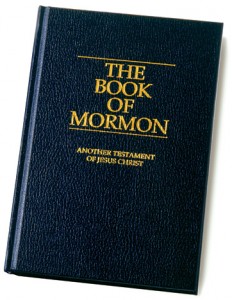The Book of Mormon is known as another testament of Jesus Christ, namely, an account of His dealings with the ancient inhabitants of the American continent. Mormons believe the Book of Mormon contains the fullness of the gospel of Christ, and reveals, clarifies, and upholds a number of doctrines and stories in the Bible. (For instance, some scholars question the stories of Jonah and Job, calling them allegorical. When Christ visited the Book of Mormon peoples, He verified those stories as true.)
 The Book of Mormon is made up of records of history, prophecy and revelation, which records were kept by ancient prophets of the Americas over hundreds of years. These records were finally abridged by a prophet named Mormon, for whom the book is named.
The Book of Mormon is made up of records of history, prophecy and revelation, which records were kept by ancient prophets of the Americas over hundreds of years. These records were finally abridged by a prophet named Mormon, for whom the book is named.
Two broad groups of people are accounted for in the Book of Mormon. One came from Jerusalem to the American continent in 600 BC and afterward separated into two nations known as the Nephites and the Lamanites. The other civilization came to the American continent much earlier and is known as the Jaredite nation.
The Jaredite nation came to the American continent after the events of the Tower of Babel – in fact, they were guided to the Americas by the hand of the Lord. Unfortunately, the nation eventually split into violent factions and destroyed itself. When Nephite explorers happened on Jaredite lands later, they called it a “land of bones.”
The Nephite nation is the focus of the Book of Mormon – and the Book of Mormon is written by Nephite prophets. They write of their testimonies and prophecies of the coming Messiah and council against sin and selfishness. Pre-Christ Book of Mormon peoples, being descendants of Jacob, lived according to the Law of Moses as they looked forward to the coming of Christ. They understood the Plan of Salvation and the atonement many years before Christ’s coming.
To a lesser degree, the book also details the Nephite wars with the other principal nation mentioned in the Book of Mormon, the Lamanites, who, “because of the traditions of their fathers,” hated the Nephites ferociously. The wars were primarily defensive, however, and a hope for the conversion of the Lamanites is a running theme throughout the book.
Another running theme throughout the Book of Mormon is something Mormons call the “pride cycle.” When the Nephites were righteous, the Lord blessed them with prosperity. Eventually, some Nephites would take pride in their prosperity and start to set themselves above the less prosperous. Pride and arrogance would always lead to a general disregard for the prophets and for precepts of the gospel, especially love and charity. The Nephite nation would fall into wickedness and would be chastened, whether by famine or war. They would then repent and the cycle would begin again.
The Lamanite nation also went through cycles. The converted Lamanites would convert with such passion and strength that they often served as examples to the Nephites. At one point, a group of converted Lamanites laid down their arms before an oncoming army of their own people and refuse to fight, because they had vowed before the Lord never to kill again. At another point, the children of these Lamanites fought alongside the Nephites and, because of their incredible faith, not one of them was killed.
Jesus Christ came to visit the people of the Nephites and Lamanites after His ministry in Palestine and His resurrection. He established His gospel and Church among the people, who had been awaiting His coming since their ancestors’ arrival six hundred years before. A golden age of peace and equanimity followed for a number of generations, but when the sure testimony of Christ faded in the memory of the people, they split back into factions and began warring again. By the fourth century after Christ’s coming, the Nephites, who had become wicked and aggressive, had been utterly destroyed. In Mormon belief, the Lamanites are the principal ancestors of some of the native peoples living in the Americas today. This would make some native North and South Americans descendants of the tribe of Joseph.
Mormon, who compiled and abridged the Book of Mormon, died in one of the final battles. His son, Moroni, added to the end of the book, and hid up the plates. (The Book of Mormon was inscribed on metal plates.) Mormons believe that, in 1823, the same Moroni appeared as a heavenly messenger to the Prophet Joseph Smith and instructed him about the ancient record. Joseph Smith later received and translated the Book of Mormon into English through the power and direction of the Lord.
Additional Resources:
Get a Free Copy of the Book of Mormon
